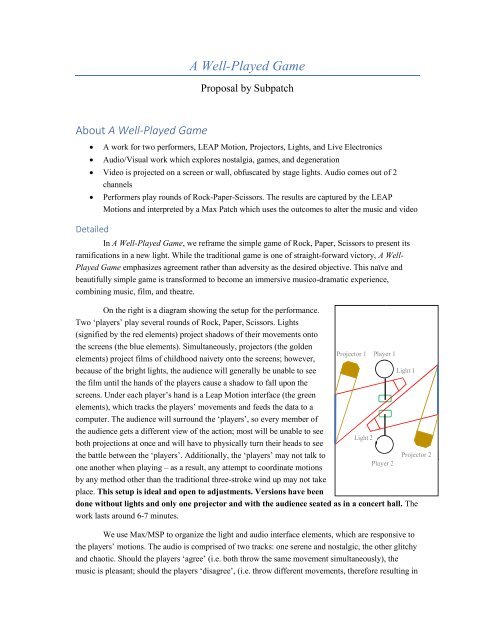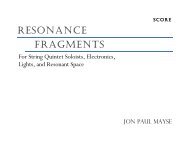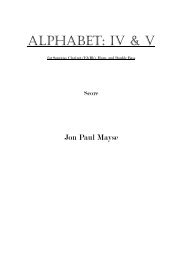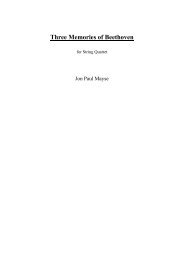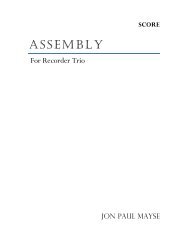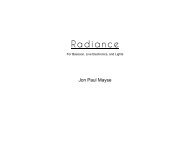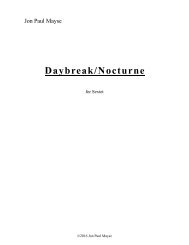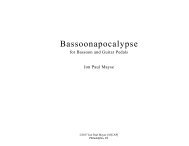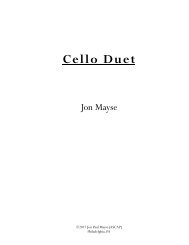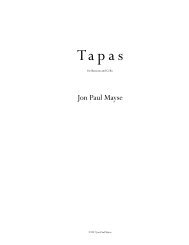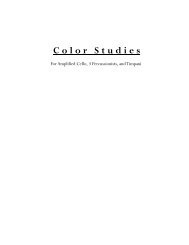Well Played Game - Subpatch - Information
A prior proposal for Well-Played Game (with some extra elements, we then cut for logistic reasons).
A prior proposal for Well-Played Game (with some extra elements, we then cut for logistic reasons).
Create successful ePaper yourself
Turn your PDF publications into a flip-book with our unique Google optimized e-Paper software.
A <strong>Well</strong>-<strong>Played</strong> <strong>Game</strong><br />
Proposal by <strong>Subpatch</strong><br />
About A <strong>Well</strong>-<strong>Played</strong> <strong>Game</strong><br />
<br />
<br />
A work for two performers, LEAP Motion, Projectors, Lights, and Live Electronics<br />
Audio/Visual work which explores nostalgia, games, and degeneration<br />
Video is projected on a screen or wall, obfuscated by stage lights. Audio comes out of 2<br />
channels<br />
<br />
Detailed<br />
Performers play rounds of Rock-Paper-Scissors. The results are captured by the LEAP<br />
Motions and interpreted by a Max Patch which uses the outcomes to alter the music and video<br />
In A <strong>Well</strong>-<strong>Played</strong> <strong>Game</strong>, we reframe the simple game of Rock, Paper, Scissors to present its<br />
ramifications in a new light. While the traditional game is one of straight-forward victory, A <strong>Well</strong>-<br />
<strong>Played</strong> <strong>Game</strong> emphasizes agreement rather than adversity as the desired objective. This naïve and<br />
beautifully simple game is transformed to become an immersive musico-dramatic experience,<br />
combining music, film, and theatre.<br />
On the right is a diagram showing the setup for the performance.<br />
Two ‘players’ play several rounds of Rock, Paper, Scissors. Lights<br />
(signified by the red elements) project shadows of their movements onto<br />
the screens (the blue elements). Simultaneously, projectors (the golden<br />
Projector 1<br />
elements) project films of childhood naivety onto the screens; however,<br />
because of the bright lights, the audience will generally be unable to see<br />
the film until the hands of the players cause a shadow to fall upon the<br />
screens. Under each player’s hand is a Leap Motion interface (the green<br />
elements), which tracks the players’ movements and feeds the data to a<br />
computer. The audience will surround the ‘players’, so every member of<br />
the audience gets a different view of the action; most will be unable to see<br />
both projections at once and will have to physically turn their heads to see<br />
the battle between the ‘players’. Additionally, the ‘players’ may not talk to<br />
Projector 2<br />
one another when playing – as a result, any attempt to coordinate motions<br />
by any method other than the traditional three-stroke wind up may not take<br />
place. This setup is ideal and open to adjustments. Versions have been<br />
done without lights and only one projector and with the audience seated as in a concert hall. The<br />
work lasts around 6-7 minutes.<br />
We use Max/MSP to organize the light and audio interface elements, which are responsive to<br />
the players’ motions. The audio is comprised of two tracks: one serene and nostalgic, the other glitchy<br />
and chaotic. Should the players ‘agree’ (i.e. both throw the same movement simultaneously), the<br />
music is pleasant; should the players ‘disagree’, (i.e. throw different movements, therefore resulting in
a ‘win’ in the traditional game), the music becomes distorted and glitchy, crossfading to the less<br />
pleasant soundtrack. The film follows suit as well – if the players ‘agree’, the lights dim and the film<br />
becomes more visible, displaying scenes of childhood gaiety, whereas upon ‘disagreement’ the film<br />
glitches and becomes uncomfortable.<br />
A <strong>Well</strong>-<strong>Played</strong> <strong>Game</strong> puts an interesting spin on the nostalgic singlemindedness of Rock,<br />
Paper, Scissors. Through the connection and subversion of nostalgic elements and childhood games,<br />
we hope to explore what it means to agree, to disagree, and to toe the line between the sentimental<br />
sublimity of childhood and the chaos of conflict.<br />
Technical Aspects<br />
<br />
<br />
<br />
We Provide:<br />
o Two Performers<br />
o Laptop with Max/MSP<br />
o LEAP Motion<br />
o USB Audio-Interface Device<br />
o Stage Lights<br />
o Peripherals for Laptop, LEAP Motion, Audio I/O Device, XLR and/or 1/4” cables,<br />
and Stage Lights<br />
We cannot provide<br />
o Speakers<br />
We are willing to rent a projector, but we would be very appreciative if one could be provided<br />
Biography<br />
Technology expands human capabilities. Yet, as technology evolves to our needs, so too do<br />
we adapt to technology. This dynamic between human and artifice is at the heart of <strong>Subpatch</strong>’s work.<br />
By employing gesture capture devices to extend human expressivity into digital domains, <strong>Subpatch</strong><br />
create multimedia experiences encompassing the range of human experience, from reflective and<br />
universal to light and absurd. <strong>Subpatch</strong> have performed their works in both the UK, at the AMOK<br />
Festival in York and at the Brunel Museum in London, and the United States, in the VU Symposium<br />
in Park City. <strong>Subpatch</strong> was founded in 2018 by Jared Bennett, Lazar Liebenberg, and Jon Paul<br />
Mayse..


